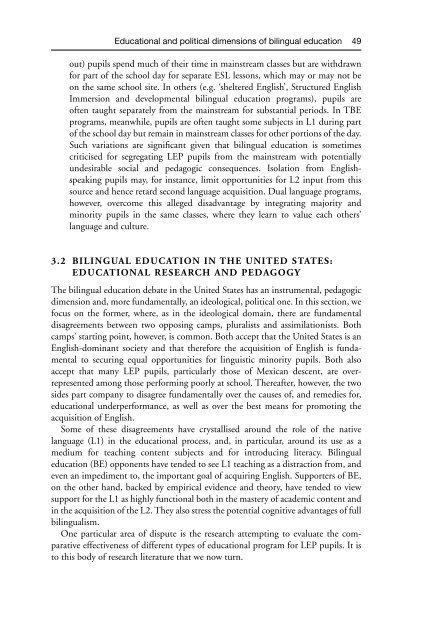Gibson Ferguson Language Planning and Education Edinburgh ...
Gibson Ferguson Language Planning and Education Edinburgh ...
Gibson Ferguson Language Planning and Education Edinburgh ...
You also want an ePaper? Increase the reach of your titles
YUMPU automatically turns print PDFs into web optimized ePapers that Google loves.
<strong>Education</strong>al <strong>and</strong> political dimensions of bilingual education 49<br />
out) pupils spend much of their time in mainstream classes but are withdrawn<br />
for part of the school day for separate ESL lessons, which may or may not be<br />
on the same school site. In others (e.g. ‘sheltered English’, Structured English<br />
Immersion <strong>and</strong> developmental bilingual education programs), pupils are<br />
often taught separately from the mainstream for substantial periods. In TBE<br />
programs, meanwhile, pupils are often taught some subjects in L1 during part<br />
of the school day but remain in mainstream classes for other portions of the day.<br />
Such variations are significant given that bilingual education is sometimes<br />
criticised for segregating LEP pupils from the mainstream with potentially<br />
undesirable social <strong>and</strong> pedagogic consequences. Isolation from Englishspeaking<br />
pupils may, for instance, limit opportunities for L2 input from this<br />
source <strong>and</strong> hence retard second language acquisition. Dual language programs,<br />
however, overcome this alleged disadvantage by integrating majority <strong>and</strong><br />
minority pupils in the same classes, where they learn to value each others’<br />
language <strong>and</strong> culture.<br />
3.2 BILINGUAL EDUCATION IN THE UNITED STATES:<br />
EDUCATIONAL RESEARCH AND PEDAGOGY<br />
The bilingual education debate in the United States has an instrumental, pedagogic<br />
dimension <strong>and</strong>, more fundamentally, an ideological, political one. In this section, we<br />
focus on the former, where, as in the ideological domain, there are fundamental<br />
disagreements between two opposing camps, pluralists <strong>and</strong> assimilationists. Both<br />
camps’ starting point, however, is common. Both accept that the United States is an<br />
English-dominant society <strong>and</strong> that therefore the acquisition of English is fundamental<br />
to securing equal opportunities for linguistic minority pupils. Both also<br />
accept that many LEP pupils, particularly those of Mexican descent, are overrepresented<br />
among those performing poorly at school. Thereafter, however, the two<br />
sides part company to disagree fundamentally over the causes of, <strong>and</strong> remedies for,<br />
educational underperformance, as well as over the best means for promoting the<br />
acquisition of English.<br />
Some of these disagreements have crystallised around the role of the native<br />
language (L1) in the educational process, <strong>and</strong>, in particular, around its use as a<br />
medium for teaching content subjects <strong>and</strong> for introducing literacy. Bilingual<br />
education (BE) opponents have tended to see L1 teaching as a distraction from, <strong>and</strong><br />
even an impediment to, the important goal of acquiring English. Supporters of BE,<br />
on the other h<strong>and</strong>, backed by empirical evidence <strong>and</strong> theory, have tended to view<br />
support for the L1 as highly functional both in the mastery of academic content <strong>and</strong><br />
in the acquisition of the L2. They also stress the potential cognitive advantages of full<br />
bilingualism.<br />
One particular area of dispute is the research attempting to evaluate the comparative<br />
effectiveness of different types of educational program for LEP pupils. It is<br />
to this body of research literature that we now turn.






